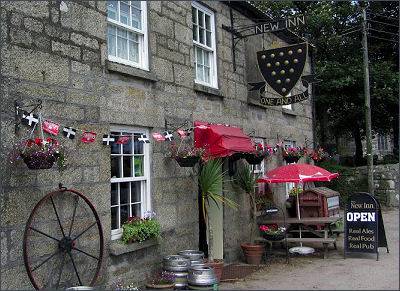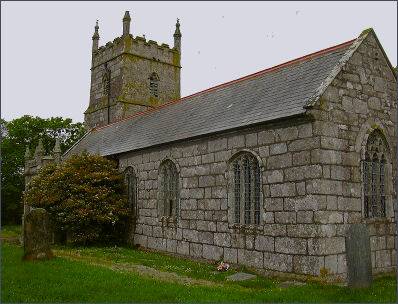Wendron
OS Grid ref:- SW 6731
 The village of Wendron lies 3 miles (5 kilometres) north of Helston, Gwendron as it was once called is known in Cornish as Egloswendron, the village lies close to the Cornwall and West Devon Mining Landscape World Heritage Site.
The village of Wendron lies 3 miles (5 kilometres) north of Helston, Gwendron as it was once called is known in Cornish as Egloswendron, the village lies close to the Cornwall and West Devon Mining Landscape World Heritage Site.
The Wendron mining district has one of the longest histories of tin working of any district in Cornwall. Underground tin mining was well advanced by the 1580s, when the most important mines were listed as Roselidden and Porkellis. Poldark Tin Mine is situated in the picturesque Wendron Valley, it contains what are believed to be the oldest complete mine workings in Great Britain that are open to the public and is now a World Heritage Site.
Once the scene of intense industrial activity, the site's attractive surroundings and gardens belie its industrial past. The unique prehistoric evidence of working for alluvial tin, the site of the first recorded tin stamps in the Duchy of Cornwall (1493) and its eighteenth century tin mine makes Poldark one of Cornwall's most important heritage sites.
The cosy village pub, the New Inn (pictured left) is traditionally built from granite and stands next to the churchyard, the building dates from the early eighteenth Century. The inn serves good, home cooked meals. There is a garden at the back which offers extensive views over the valley.
 The medieval village church of St. Wendron, a Grade I listed building, dates back to the fourteenth century. The building is cruciform in shape but was enlarged in the fifteenth century, very little is known about the saint who gave her name to the church. Before 1284 Edmund, Earl of Cornwall, son of Richard, 1st Earl of Cornwall and grandson of King John, gave the church of Wendron to Rewley Abbey near Oxford. Before this it had belonged to his manor of Helston which included the whole parish.
The medieval village church of St. Wendron, a Grade I listed building, dates back to the fourteenth century. The building is cruciform in shape but was enlarged in the fifteenth century, very little is known about the saint who gave her name to the church. Before 1284 Edmund, Earl of Cornwall, son of Richard, 1st Earl of Cornwall and grandson of King John, gave the church of Wendron to Rewley Abbey near Oxford. Before this it had belonged to his manor of Helston which included the whole parish.
Entrance to the churchyard is through an unusual seventeenth century lychgate with a room above it. The exterior of the church is largely unaltered since the fifteenth century, the interior retains the original interior waggon roofs over the nave and north transept. The interesting church contains a fifteenth century font which is shaped like a chalice and the double headed eagle arms of Richard Plantagenet, Earl of Cornwall and 'King of the Romans', may be seen by the pulpit. The church was extensively refurbished in the mid-nineteenth century. In the churchyard stands an eighteenth century pillar sundial and an ancient Celtic cross near the church porch.
The holy well of St Wendrona is located at Trelill and nearby stood her chapel, licensed in 1427, about the same date as the well. The well is a small square building, with a granite arched doorway. Inside, either side of the doorway, are stone benches for pilgrims and in the back wall, three small niches and a low arched entrance to a small chamber containing the spring. Legend states that the original site chosen for the church is the site now occupied by the well because crows persistently moved the stones until the builders admitted defeat and built the church in it's present location in Wendron.
Visitor Attractions on the Lizard Peninsula
National Seal Sanctuary at Gweek, founded in 1958 and devoted to seal rescue and care, baby seals are in the sanctuary from September - March. Open daily, except Christmas Day, from 10a.m..
Lizard LighthouseThe Lizard Lighthouse is open to the public, a visitor car park is provided by the entrance gate. Visitors may ascend the 70 metre high lighthouse tower from where there are stunning views. The coastline around the lighthouse offers spectacular walks along the cliffs. Open July 11.00 - 18.00, August 11.00-19.00
*Lizard Countryside Centre fully interactive exhibition based on local countryside, history and wildlife. Open Easter - Oct, daily, 11am - 5pm.
Bonython Manor The superb garden at Bonython covers 20 acres and its plantations of Montrerey pine and beech trees were planted in the 1830s. There is much for the gardening enthusiast to see at Bonython. Open April - October, Tuesday, Wednesday, Thursday and Friday, 10.00am - 4.30pm
*Trelowarren House and Craft Centre Magwan-in-Meneage, Elizabethan style Stuart building with a Victorian interior, home to the Vyvyan family, hosts crafts exhibition. Open all year.
*Marconi Memorial , Poldhu, art deco obelisk just south of Poldhu Bay, first radio signals across Atlantic were sent from here by Guglielmo Marconi.
*Goonhilly Earth Station, futuristic satellite tracking station built in 1962, visitor centre with interactive displays and hands on exhibitions, tours of the site. Open, Easter - Oct, 10am - 5pm (6pm in high season).